#sql interview questions and answers
Text
Top 30 SQL Interview Questions and Answers for Fresher and Experienced
Sure! Here are the top 30 SQL interview questions and answers for both fresher and experienced candidates:
What is SQL?
SQL stands for Structured Query Language, and it is a programming language designed for managing and manipulating relational databases.
What are the different types of SQL statements?
There are four main types of SQL statements:Data Manipulation Language (DML) statements…
View On WordPress
0 notes
Text
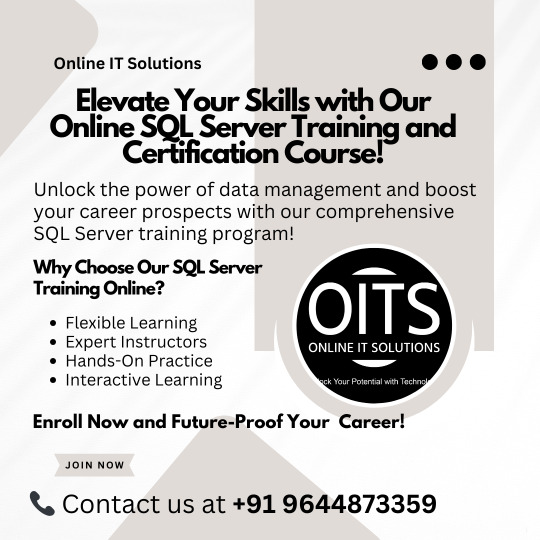
sql server interview questions and answers
Elevate your career with our SQL Certification Course. Comprehensive SQL Server training online for success in the data-driven world.
sql server course fees , sql server interview questions , sql server interview questions and answers , sql certification course , sql server training online
#sql server course fees#sql server interview questions#sql server interview questions and answers#sql certification course#sql server training online#data analytics#power bi certification#power bi certification cost#sql#power bi course#msbi#education#power bi#power bi course fees#power bi online training
1 note
·
View note
Text

SQL Interview Questions
The following SQL interview questions and answers are designed to familiarize candidates with common interview questions.
#besttraininginstitute#traininginstitute#onlinetraining#training#online#coding#tutorial#technology#trending#design#infographics#sql#mysql#database#programming#engineering
4 notes
·
View notes
Text
Angular Interview Questions and Answers: Part 11
This is the 11th part of the Angular Interview Questions and Answers Series. In this part we will discuss the answers of the following Angular Questions:
Q122. What are Directives in Angular? When to use directive?
Q123. What are the different types of directives in Angular?
Q124. What is the use of the *ngFor directive? What is the difference between the *ngFor vs. ngForOf directive in Angular?
Q125. What is the index property in *ngFor directive? What is the use of index property in *ngFor directive?
Q126. What is the purpose of *ngFor trackBy in Angular?
Q127. What is the use of the *ngIf directive in Angular?
Q128. What is the difference between the *ngIfElse vs. *ngIf directive in SQL?
Q129. How can you use both *ngFor and *ngIf directives together on the same element?
Q130. What is the difference between the *ngIf directive vs. hidden property in Angular?
Q131. What is the use of the *ngSwitch directive?
Q132. What is the difference between the *ngStyle vs. *ngClass directive in Angular?
Q133. What is the use of ng-template in Angular?
Q134. What is the use of the ngModel directive in Angular? What is the "banana-in-a-box" syntax in Angular?
Q135. What is the difference between the (ngModel) vs [ngModel] vs [(ngModel)] directive in Angular?
Please visit the following link for the Answers of the above Angular Interview Questions:
#angularpart11#angularinterviewquestions#mostfrequentlyaskedangularquestions#angularfresherinterviewquestions#angularexperiencedinterviewquestions#commonangularinterviewquestions#angularinterview2023#techpointfundamentals#techpointfunda#techpoint#techpointblog
2 notes
·
View notes
Photo

10 Ultimate SQL JOIN Questions and Answers For Data Science Interview 🏥 #photodump · What is SQL JOIN and its use? · What are different types of SQL JOINs? · How will you write a SQL query to join two tables and get all the rows of the first table? · What is CROSS JOIN in SQL? · What is SELF JOIN in SQL and when do you use it? · How do you JOIN more than two tables in SQL? · What is Equi and Non-Equi JOIN? · How many rows will you get using LEFT JOIN and INNER JOIN on two tables? · Can you generate same results using LEFT and RIGHT JOINs? · How do the UNION is different from JOIN in SQL? . . . 🌟🔥#fy #fyp #viral #new #trending #technology #techtok #techgadget #lifehack #lifehacks #tictokmademebuyit #screen #carsextenedwarranty #extendedscreen #computer #macbook#folding#foryourpage #fyp #pythonlibrary #sql #interview #dataanalyst #datascientist (Medicana Ataşehir Hastanesi) https://www.instagram.com/p/ClHZ0EMICDe/?igshid=NGJjMDIxMWI=
#photodump#fy#fyp#viral#new#trending#technology#techtok#techgadget#lifehack#lifehacks#tictokmademebuyit#screen#carsextenedwarranty#extendedscreen#computer#macbook#folding#foryourpage#pythonlibrary#sql#interview#dataanalyst#datascientist
7 notes
·
View notes
Text
sap hana certification course uk 1
Sap Training Find And Examine
We will share sample resumes for reference and we'll information you to organize finest skilled trying resume. But we won't draft your resume because of legal restrictions. It is your resume and no matter you submit as your resume, we are going to market the same. You will reply all the interviewer’s questions with confidence, If you set your efforts to prepare resume.

Topics lined embody iFlow objects, security, SCP integration and Software as a service. Our students have free entry to the SAP Next Gen learning hub, the place 19 certification tracks can be found. Each certification is cloud-based and can be accessed on-line from wherever on the planet.
But if you would like to be taught SAP BW on HANA, then studying BW is a must. Yes, you probably can be taught and make a profession in SAP HANA with minimum information of fundamental database information (2-3 hours) after which start learning HANA. Students attending training via Online LIVE Training have a real-time, Live Instructor-Led pupil expertise through the world-class Virtual Learning Campus. Online LIVE Training supplies an enticing live classroom environment that permits students to simply work together with instructors and fellow college students just about. This certification supplies an understanding of SAP SuccessFactors, Employee Central.
Sap S/4hana Finance Training (vs Sap Fico) – Configuration & End-user
Delegates will learn the methods to set the web page background color for a theme and configure accent color schemes in quick themes. They may even study in regards to the individuals analytics directory for managing performance processes and analysing gaps inside performance types. This course is led by our extremely professional and skilled coach, who has years of experience in teaching SAP courses.
youtube
SAP Business Intelligence (SAP BI/BW) is the centrepiece of SAP’s Analytics and knowledge warehousing answer. SAP Finance and Controlling relies on pure accounting rules which offer core accounting and reporting capabilities and ensures probably the most up-to-date balances and reporting accuracy. This certification is anxious with the administration of talent within an organisation, using the SAP SuccessFactors platform.
Sap Knowledge Warehouse Cloud Training Course Overview
We are most well-liked SAP coaching partner for a few of UK's greatest corporations. Our community of companion corporations helps us to leverage our association and convey you the best placements. From CV constructing to the interview process, our recruitment team guides you step-by-step to secure your first SAP job. This certification covers the fundamental end-to-end enterprise processes within S/4HANA and is really helpful as an entry qualification for the S/4HANA Platform.
Register along with your college e-mail address to gain entry to this unique SAP Learning Journey about Intelligent Enterprise enterprise processes.
Those on this place have to be affected person and flexible, as end-users often revise system necessities.
In short, it is named SAP BW/4 HANA that is well known for the on-premise information warehouse layer of the SAP’s Business Technology Infrastructure.
Certification assistance supplied with correct guidance and certification dumps.
Index Server is the main database component which consists of actual knowledge engines for knowledge processing together with SQL and MDX statements and performs the authentic transactions.
The courses are run by experts with ample business expertise on this material. The course run are nicely up to professional standards with the most recent trade updates. Contact our group at Jenrac Technologies for all your queries.
sap hana course london of our programs are designed to get you a job first and are also geared for you to get certified. After the course completion, your coach will present all details in regards to the certification you probably can seem for the skills of every. We additionally offer you Certification faqs and dumps from previous certification exams.
It is a solution for all sorts of business wants the place you can get real-time business insights and utilizing superior analytics in SAP analytics. After attending this training, delegates will be capable of integrate contract compliance and SAP processes for the requirements of each the provider and supply-side within the supply chain process. They may even be capable of develop a requisition that requires certain materials to tell purchasing and account project data. Throughout this coaching, delegates will perceive the SAP Business ByDesign supports the stakeholders of project-based companies, and project management performance.
The shoppers are given a chance where they can tailor the length after all in accordance with their requirements and the coaching could be delivered in house/ at your location of selection or online. Although there is not any assure of a job on target completion we are nearly sure that you need to be ready to discover a suitable position inside a quantity of weeks after profitable completion of the course. Creation of grasp data primarily based on table, view, infosets and Function module. SAP BW on HANA (High-Performance Analytical Appliance) is a whole answer for the data warehouse of any enterprise. In brief, it is called SAP BW/4 HANA that is well known for the on-premise data warehouse layer of the SAP’s Business Technology Infrastructure.
#sap hana certification course uk#sap hana certification training uk#sap hana training london#sap hana course london#sap hana course sap hana training uk#sap hana course uk
2 notes
·
View notes
Text
Unlock Success: MySQL Interview Questions with Olibr
Introduction
Preparing for a MySQL interview requires a deep understanding of database concepts, SQL queries, optimization techniques, and best practices. Olibr’s experts provide insightful answers to common mysql interview questions, helping candidates showcase their expertise and excel in MySQL interviews.
1. What is MySQL, and how does it differ from other database management systems?
Olibr’s Expert Answer: MySQL is an open-source relational database management system (RDBMS) that uses SQL (Structured Query Language) for managing and manipulating databases. It differs from other DBMS platforms in its open-source nature, scalability, performance optimizations, and extensive community support.
2. Explain the difference between InnoDB and MyISAM storage engines in MySQL.
Olibr’s Expert Answer: InnoDB and MyISAM are two commonly used storage engines in MySQL. InnoDB is transactional and ACID-compliant, supporting features like foreign keys, row-level locking, and crash recovery. MyISAM, on the other hand, is non-transactional, faster for read-heavy workloads, but lacks features such as foreign keys and crash recovery.
3. What are indexes in MySQL, and how do they improve query performance?
Olibr’s Expert Answer: Indexes are data structures that improve query performance by allowing faster retrieval of rows based on indexed columns. They reduce the number of rows MySQL must examine when executing queries, speeding up data retrieval operations, and optimizing database performance.
4. Explain the difference between INNER JOIN and LEFT JOIN in MySQL.
Olibr’s Expert Answer: INNER JOIN and LEFT JOIN are SQL join types used to retrieve data from multiple tables. INNER JOIN returns rows where there is a match in both tables based on the join condition. LEFT JOIN returns all rows from the left table and matching rows from the right table, with NULL values for non-matching rows in the right table.
5. What are the advantages of using stored procedures in MySQL?
Olibr’s Expert Answer: Stored procedures in MySQL offer several advantages, including improved performance due to reduced network traffic, enhanced security by encapsulating SQL logic, code reusability across applications, easier maintenance and updates, and centralized database logic execution.
Conclusion
By mastering these MySQL interview questions and understanding Olibr’s expert answers, candidates can demonstrate their proficiency in MySQL database management, query optimization, and best practices during interviews. Olibr’s insights provide valuable guidance for preparing effectively, showcasing skills, and unlocking success in MySQL-related roles.
1 note
·
View note
Text
How Should I Prepare For a Full Stack Developer interview?
How to Prepare for a Full Stack Developer Interview

Preparing for a full stack developer interview involves a combination of technical knowledge, problem-solving skills, and familiarity with common tools and technologies. Here are some steps you can follow to prepare effectively:
Understand the Job Description: Carefully read the job description to understand the specific skills, technologies, and responsibilities required for the position.
Review Core Concepts: Brush up on fundamental programming concepts such as data structures, algorithms, object-oriented programming, and design patterns. Ensure you're comfortable with both front-end and back-end technologies.
Learn Relevant Technologies: Familiarize yourself with the technologies mentioned in the job description. This may include programming languages (e.g., JavaScript, Python, Java, etc.), front-end frameworks (e.g., React, Angular, Vue.js), back-end frameworks (e.g., Node.js, Django, Flask), databases (e.g., SQL, NoSQL), version control systems (e.g., Git), and deployment tools (e.g., Docker, Kubernetes).
Practice Coding: Practice coding challenges on platforms like LeetCode, HackerRank, or CodeSignal. Focus on algorithms, data structures, and problem-solving techniques. Also, practice implementing CRUD operations, authentication, and authorization in a full stack application.
Build Projects: Create or contribute to projects that showcase your full stack development skills. This could be personal projects, open-source contributions, or projects from online coding courses. Be prepared to discuss the architecture, technologies used, challenges faced, and your contributions to these projects.
Prepare for System Design: For senior-level positions, be ready to discuss system design principles. Practice designing scalable and efficient systems, considering aspects like database design, caching strategies, load balancing, and microservices architecture.
Mock Interviews: Conduct mock interviews with friends, colleagues, or mentors. Practice explaining your thought process, solving coding problems on a whiteboard or online platform, and answering technical questions related to full stack development.
Research the Company: Learn about the company's products, services, culture, and technology stack. Tailor your answers during the interview to demonstrate how your skills and experience align with the company's needs and goals.
Prepare Questions: Prepare thoughtful questions to ask the interviewer about the company, team structure, projects, and future opportunities. This shows your interest and engagement in the role.
Stay Updated: Keep abreast of the latest trends, updates, and best practices in full stack development by reading blogs, following industry experts, attending webinars, and participating in relevant online communities.
Introduction to Full Stack Development
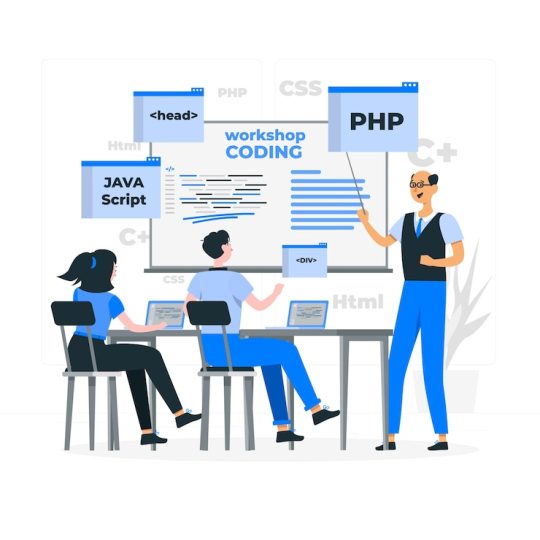
Full stack development is a term used to describe the comprehensive skill set required to develop both the front end and back end of web applications. It involves working with both client-side and server-side technologies to create fully functional and interactive web applications. A full stack developer is someone who is proficient in various programming languages, frameworks, databases, and other tools necessary for building the different components of a web application.
Let's break down the key components of full stack development:
Front End Development: This involves everything that users interact with directly in a web application. It includes the user interface (UI) design, user experience (UX) optimization, and client-side programming. Technologies commonly used in front end development include HTML, CSS, and JavaScript, along with frameworks/libraries like React, Angular, or Vue.js for building dynamic and responsive user interfaces.
Back End Development: This part of development focuses on the server-side logic, databases, and server management required to power the web application. Back end developers work with server-side languages like Node.js, Python (with frameworks like Django or Flask), Ruby (with Rails), or Java (with Spring Boot). They also interact with databases such as MySQL, PostgreSQL, MongoDB, or Firebase for data storage and retrieval.
Database Management: Full stack developers should have a good understanding of database management systems (DBMS) and how to design efficient database schemas. They work with SQL (Structured Query Language) for relational databases and NoSQL databases like MongoDB for non-relational data storage.
Version Control Systems: Full stack developers use version control systems like Git to manage and track changes in the codebase, collaborate with other developers, and maintain a history of code revisions.
Deployment and DevOps: Understanding deployment processes, continuous integration/continuous deployment (CI/CD) pipelines, and basic DevOps principles is crucial for full stack developers. They deploy applications to hosting platforms like AWS, Heroku, or Azure and ensure the application runs smoothly in production environments.
Soft Skills: In addition to technical skills, full stack developers should possess good problem-solving abilities, communication skills, teamwork skills, and the ability to adapt to new technologies and tools quickly.
Preparing for a Full Stack Developer Interview

Before diving into the interview process, it's crucial to:
Preparing for a Full Stack Developer interview requires a solid understanding of both frontend and backend technologies, as well as concepts related to web development, databases, version control, and deployment. Here are some key steps to help you prepare effectively:
Review Core Concepts:
Make sure you have a strong understanding of programming languages such as JavaScript, Python, Java, or others commonly used in full-stack development.
Familiarize yourself with frontend frameworks like React, Angular, or Vue.js, as well as backend frameworks like Node.js, Flask, Django, Spring Boot, etc.
Understand RESTful API principles, HTTP protocols, and web development concepts such as DOM manipulation, responsive design, and browser compatibility.
Database Knowledge:
Brush up on database concepts including SQL queries, database design, normalization, indexing, and transactions.
Familiarize yourself with popular database management systems like MySQL, PostgreSQL, MongoDB, etc.
Understand how to integrate databases with backend applications using ORM tools like Hibernate, Sequelize, or SQLAlchemy.
Version Control and Collaboration:
Practice using version control systems like Git and platforms like GitHub or GitLab.
Understand branching strategies, merging, resolving conflicts, and collaborating with other developers using Git workflows.
Data Structures and Algorithms:
Review fundamental data structures such as arrays, linked lists, stacks, queues, trees, graphs, and hash tables.
Practice algorithmic problem-solving techniques and understand time complexity, space complexity, and Big O notation.
Web Development Tools and Technologies:
Familiarize yourself with frontend build tools like Webpack, Babel, npm, or yarn.
Understand CSS preprocessors like Sass or Less, and frontend testing frameworks like Jest, Mocha, or Jasmine.
Learn about backend testing frameworks such as JUnit, Pytest, or Jasmine for Node.js.
Deployment and DevOps:
Understand deployment strategies including containerization with Docker and orchestration with Kubernetes.
Learn about Continuous Integration/Continuous Deployment (CI/CD) pipelines using tools like Jenkins, Travis CI, or GitHub Actions.
Familiarize yourself with cloud platforms like AWS, Azure, Google Cloud Platform, or Heroku for deploying and managing applications.
Soft Skills and Communication:
Practice communicating technical concepts clearly and concisely, both verbally and in writing.
Prepare to discuss your past projects, experiences, and problem-solving approaches during the interview.
Demonstrate your ability to work in a team, collaborate with others, and adapt to new technologies and challenges.
Mock Interviews and Practice Questions:
Conduct mock interviews with friends, colleagues, or through online platforms to simulate real interview scenarios.
Practice answering common interview questions related to your technical skills, problem-solving abilities, project experiences, and teamwork.
Stay Updated:
Keep up-to-date with industry trends, new technologies, and best practices in full-stack development through blogs, forums, online courses, and conferences.
By following these steps and dedicating time to study and practice, you'll be well-prepared to ace your Full Stack Developer interview. Good luck!
Java Full Stack Developer Course Syllabus
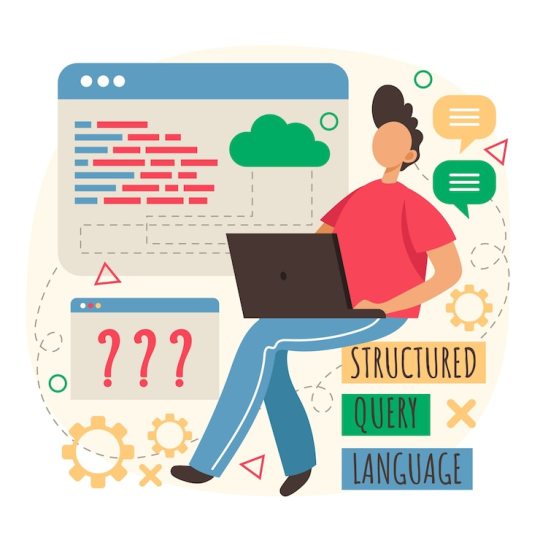
For aspiring Java Full Stack Developers, a comprehensive course syllabus may include:
Week 1-2: Introduction to Python for Web Development
Introduction to Python programming language
Setting up development environment (Python, text editor/IDE)
Basic syntax, data types, and control structures in Python
Introduction to web development with Python (Flask or Django)
Week 3-4: Frontend Development
HTML5 fundamentals
CSS3 for styling web pages
Introduction to JavaScript and DOM manipulation
Frontend frameworks/libraries (e.g., Bootstrap, React)
Week 5-6: Backend Development with Python
Introduction to backend development concepts
Using Flask or Django for backend development
Routing, views, and templates
Handling HTTP requests and responses
Week 7-8: Database Management
Introduction to databases (SQL and NoSQL)
Using SQLite with Python
ORM (Object-Relational Mapping) with SQLAlchemy
Database design and normalization principles
Week 9-10: Building RESTful APIs
Understanding RESTful architecture
Creating RESTful APIs with Flask or Django REST framework
Authentication and authorization for APIs
Consuming APIs using HTTP client libraries
Week 11-12: Deployment and DevOps
Introduction to cloud platforms (e.g., AWS, Heroku)
Deployment strategies for web applications
Continuous Integration and Continuous Deployment (CI/CD)
Monitoring and scaling web applications
Week 13-14: Project Development
Collaborative project work in teams
Applying concepts learned throughout the course
Version control with Git/GitHub
Final project presentations and demonstrations
Assessments:
Quizzes and exams covering theoretical and practical concepts
Programming assignments and projects
Peer code reviews and project evaluations
Final project presentation and report
Recommended Resources:
"Flask Web Development" by Miguel Grinberg
"Django for Beginners" by William S. Vincent
Online documentation for Flask, Django, SQLAlchemy, etc.
Web development tutorials and forums (e.g., Stack Overflow, GitHub)
Note: This syllabus is subject to change based on instructor discretion and course updates. Students are expected to actively engage in discussions, seek clarification when needed, and participate in all course activities.
Java Full Stack Developer Course Syllabus
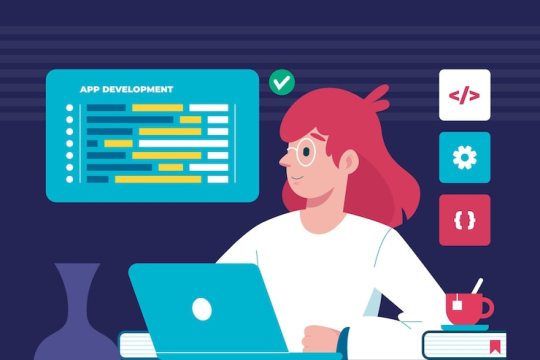
Certainly! Here's an example of a Java Full Stack Developer course syllabus. This syllabus covers a range of topics from frontend development using Java-related technologies to backend development and database management.
This course is designed to equip students with the skills and knowledge required to become a proficient full-stack developer using Java-based technologies. Students will learn frontend development, backend development, database management, and deployment strategies to build dynamic web applications.
Week 1-2: Introduction to Java for Web Development
Introduction to Java programming language
Setting up Java Development Kit (JDK) and Integrated Development Environment (IDE)
Basic syntax, data types, and control structures in Java
Introduction to web development with Java (e.g., Spring Boot)
Week 3-4: Frontend Development with Java
HTML5 and CSS3 fundamentals
Introduction to JavaScript and DOM manipulation
Frontend frameworks/libraries (e.g., Thymeleaf, Angular, React)
Integrating frontend with Java backend using RESTful APIs
Week 5-6: Backend Development with Java
Introduction to backend development concepts
Using Spring Boot for backend development
Building RESTful APIs with Spring MVC or Spring WebFlux
Handling HTTP requests and responses
Week 7-8: Database Management
Introduction to databases (SQL and NoSQL)
Using MySQL or PostgreSQL with Java applications
ORM (Object-Relational Mapping) with Hibernate or JPA
Database design and normalization principles
Week 9-10: Advanced Java Concepts
Exception handling and error management
Multithreading and concurrency in Java
File I/O operations and serialization
Java design patterns and best practices
Week 11-12: Deployment and DevOps
Introduction to cloud platforms (e.g., AWS, Azure)
Deployment strategies for Java web applications
Containerization with Docker
Continuous Integration and Continuous Deployment (CI/CD) pipelines
Week 13-14: Project Development
Collaborative project work in teams
Full-stack application development using Java technologies
Version control with Git/GitHub
Final project presentations and demonstrations
Assessments:
Quizzes and exams covering theoretical and practical concepts
Programming assignments and projects
Peer code reviews and project evaluations
Final project presentation and report
Recommended Resources:
"Spring Boot in Action" by Craig Walls
"Java: The Complete Reference" by Herbert Schildt
Online documentation for Spring Framework, Hibernate, Docker, etc.
Web development tutorials and forums (e.g., Stack Overflow, GitHub)
Full Stack Python Syllabus
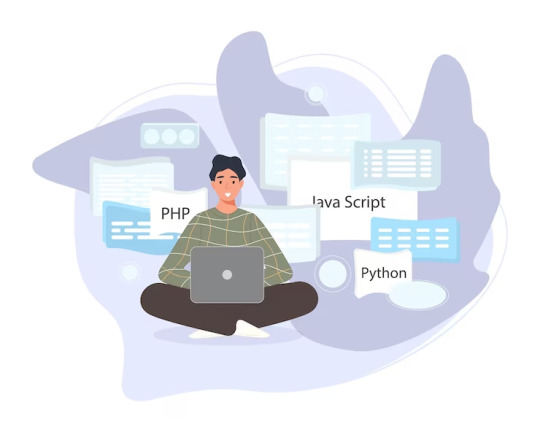
On the other hand, a full stack python syllabus may cover:This course provides an in-depth exploration of full-stack web development using the Python programming language. Students will learn to build dynamic web applications by combining frontend technologies with backend frameworks and databases.
Week 1-2: Introduction to Python for Web Development
Introduction to Python programming language
Setting up development environment (Python, text editor/IDE)
Basic syntax, data types, and control structures in Python
Introduction to web development with Python (Flask or Django)
Week 3-4: Frontend Development
HTML5 fundamentals
CSS3 for styling web pages
Introduction to JavaScript and DOM manipulation
Frontend frameworks/libraries (e.g., Bootstrap, React)
Week 5-6: Backend Development with Python
Introduction to backend development concepts
Using Flask or Django for backend development
Routing, views, and templates
Handling HTTP requests and responses
Week 7-8: Database Management
Introduction to databases (SQL and NoSQL)
Using SQLite with Python
ORM (Object-Relational Mapping) with SQLAlchemy
Database design and normalization principles
Week 9-10: Building RESTful APIs
Understanding RESTful architecture
Creating RESTful APIs with Flask or Django REST framework
Authentication and authorization for APIs
Consuming APIs using HTTP client libraries
Week 11-12: Deployment and DevOps
Introduction to cloud platforms (e.g., AWS, Heroku)
Deployment strategies for web applications
Continuous Integration and Continuous Deployment (CI/CD)
Monitoring and scaling web applications
Week 13-14: Project Development
Collaborative project work in teams
Applying concepts learned throughout the course
Version control with Git/GitHub
Final project presentations and demonstrations
Assessments:
Quizzes and exams covering theoretical and practical concepts
Programming assignments and projects
Peer code reviews and project evaluations
Final project presentation and report
Recommended Resources:
"Flask Web Development" by Miguel Grinberg
"Django for Beginners" by William S. Vincent
Online documentation for Flask, Django, SQLAlchemy, etc.
Web development tutorials and forums (e.g., Stack Overflow, GitHub)
Note: This syllabus is subject to change based on instructor discretion and course updates. Students are expected to actively engage in discussions, seek clarification when needed, and participate in all course activities.
By following a structured course syllabus and practicing hands-on coding, you can gain the necessary skills to excel as a Full Stack Developer in either Java or Python ecosystems.
Conclusion
Preparing for a Full Stack Developer interview requires a combination of technical knowledge, practical skills, and preparation strategies. By focusing on the key skills, understanding course syllabi, and practicing interview scenarios, you'll be well-equipped to showcase your expertise and land your dream job as a Full Stack Developer.
Unique FAQs
**What is the average salary of a Full Stack Developer?
The average salary of a Full Stack Developer varies based on location, experience, and company size. In general, Full Stack Developers command competitive salaries due to their in-demand skills.
**Do I need a degree to become a Full Stack Developer?
While a degree in Computer Science or a related field can be beneficial, many Full Stack Developers are self-taught or have completed coding bootcamps. What's essential is a strong grasp of programming fundamentals and practical experience.
**Are there online courses available for Java Full Stack Development?
Yes, numerous online platforms offer comprehensive courses on Java Full Stack Development, covering everything from core Java concepts to advanced frameworks and deployment strategies.
**How can I stay updated with the latest trends in Full Stack Development?
To stay updated, follow industry blogs, participate in online communities like Stack Overflow and GitHub, attend webinars and conferences, and continuously upskill through online courses or self-directed learning.
**What are some common challenges faced by Full Stack Developers?
Common challenges include managing multiple technologies, staying updated with evolving frameworks and tools, debugging complex issues, and ensuring seamless integration between frontend and backend components.
0 notes
Text
0 notes
Text

Overview: A career transformation can be a confusing but rewarding journey, especially if you are transitioning from a non-IT background to the field of analytics. In this blog, we will explore the steps, skills, and insights needed to become a successful person in the world of analytics, irrespective of any background.
Understanding the Analytics Landscape: Start by gaining a solid understanding of what analytics entails. Explore the different branches such as data analytics, business analytics, and data science. Identify the key roles and responsibilities within these domains and the industries that are actively seeking analytics professionals.
Identifying Transferable Skills: Assess your current skill set and identify transferable skills that can be leveraged in the analytics field. Skills such as problem-solving, critical thinking, attention to detail, and communication are valuable across various domains, including analytics.
Building a Strong Educational Foundation: While a formal education in analytics can be beneficial, it’s not always a prerequisite. There are numerous online / Offline courses, certifications, and workshops that cater to individuals with diverse backgrounds. Asquare Technologies offer comprehensive courses in analytics from Industry Experts.
Mastering Essential Tools and Technologies: Familiarize yourself with key tools and technologies used in the analytics field. Learn to work with analytics tools such as Python, R, SQL, and popular data visualization tools like Microsoft Power BI and Tableau. Asquare’s Online and Offline Programs and hands-on projects can help you build practical skills.
Networking and Industry Exposure: Networking is crucial for any career transition. Attend industry conferences, webinars, and local meetups to connect with professionals in the analytics field. Join online forums and communities like LinkedIn groups to stay updated on industry trends and connect with like-minded individuals.
Showcasing Your Skills Through Projects: Build a portfolio showcasing analytics projects you’ve worked on. This could include personal projects, case studies, or contributions to open-source initiatives. A strong portfolio is a tangible way to demonstrate your skills to potential employers. Asquare Technologies makes you to show case your skills with our Project Demonstration by each students after training completion.
Seeking Mentorship and Guidance: Reach out to professionals who have successfully transitioned from a non-IT background to analytics. Seeking mentorship can provide valuable insights, guidance, and a roadmap for your career transition.
Tailoring Your Resume and Cover Letter: Craft a compelling resume that highlights your transferable skills and showcases your commitment to transitioning into analytics. Tailor your cover letter to emphasize your motivation, skills, and any relevant experiences that align with the analytics field.
Preparing for Interviews: Asquare’s Mock Interview session makes you to be prepared for analytics-related interview questions. Practice answering questions that assess your problem-solving abilities, technical skills, and understanding of analytics concepts. Showcase your enthusiasm for learning and adapting to new challenges.
Continuous Learning and Adaptation: The field of analytics is ever-evolving. Commit to continuous learning and staying updated on the latest tools, techniques, and industry trends. This mindset will not only help you secure a role but also thrive in the dynamic analytics landscape.
Conclusion: Transitioning from a non-IT background to a thriving career in analytics is an achievable goal with the right mindset, skills, and strategic planning. Embrace the learning journey, stay persistent, and leverage your unique background as a strength in the analytics world. Your future in analytics awaits – Create the gateway to a rewarding and fulfilling career!
#careerguidance#career#business analytics course in kochi#data analytics course#data analytics course in kochi
0 notes
Text
sql server training online
Elevate your career with our SQL Certification Course. Comprehensive SQL Server training online for success in the data-driven world.
sql server course fees ,sql server interview questions ,sql server interview questions and answers ,sql certification course ,sql server training online
#sql server course fees#sql server interview questions#sql server interview questions and answers#sql certification course#sql server training online#data analytics#power bi certification#power bi certification cost#sql#power bi course#msbi#education#power bi online training#power bi course fees#power bi
1 note
·
View note
Text
Tech Point's Available Posts List:
Please find our all the available posts here:
3 notes
·
View notes
Text
Top 5 Intermediate MongoDB Interview Questions for Experienced Developers
MongoDB has become one of the most popular NoSQL database platforms many large tech companies use. As MongoDB adoption grows, more companies hire MongoDB developers, database administrators, and other roles. Technical interviews play a crucial role in assessing a candidate's MongoDB skills.
If you have experience with MongoDB and want to make a career move, intermediate-level MongoDB interview questions require more in-depth knowledge. This blog has compiled a list of the top 5 commonly asked MongoDB interview questions for experienced professionals. Read on to learn what to expect and get tips to prepare for your MongoDB job interview thoroughly.
1. Explain Sharding in MongoDB and Its Benefits.
MongoDB uses sharding to spread data over multiple machines. It is an integral instrument in such body of cases as where a data set becomes too massive that it can no longer be handled efficiently by any one machine. This technique makes query responses faster, ensures better load balancing, and resolves hardware limitations. Knowing how to work with sharding is key for developers to deal with large-scale deployments successfully.
2. Describe the Working of Indexes in MongoDB.
Indexes in MongoDB are very important as they improve the performance of database operations. They have a function similar to the indexes of a library book that allows you to search for the information you need without reading the whole book. Indexes on MongoDB enable the database to execute searches in a subset of the data, thus facilitating query performance. A proficient developer should know how an index is created and maintained and the relationships between an index and its impact on both read and write operations.
https://jpcdn.it/img/small/2663e2b30c8593eab5a80067920a47c9.jpg
3. How Does MongoDB Handle Transactions?
Managing database transactions in MongoDB is an important subject. MongoDB employs the idea of multi-document ACID transactions, which means that actions that involve working with more than a single document are processed with an all-or-nothing approach. This means either all operations succeed or none do and thus, the data integrity is maintained. Knowledge of the transaction plays a crucial role for developers to ensure data consistency, especially in the case of applications where several document edits must be considered from the standpoint of a single atomic operation.
4. Explain the Aggregation Framework in MongoDB.
The Aggregation Framework is a very efficient feature in MongoDB for data transformation and analysis. It deals with data records and pumps out computed results as though SQL uses GROUP BY clauses. This framework employs different stages, such as filtering, grouping, and projection, which convert the data into a required format. This framework understanding is very important for developers when conducting advanced data analysis and transformations efficiently.
5. How Does MongoDB Integrate with Node.js?
Thanks to the non-blocking architecture, MongoDB integrates perfectly with Node.js, and it is one of the favorite solutions of many Node.js developers working with Node.js applications. MongoDB stores data in a JSON-like format that is quite compatible with the JavaScript-based environment of Node.js. Developers should know how to use MongoDB’s native drivers or third-party libraries such as Mongoose, to work with the database, perform CRUD operations, and manage real-time data updates within Node.js applications.
Conclusion
This blog covered the most commonly asked interview questions mongodb with preparation tips. Use MongoDB documentation, online courses and practice tests to gain in-depth expertise over these intermediate concepts. Ensure you can back up your knowledge with real configuration experience.
InterviewCraze offers more detailed MongoDB interview questions with answers to accelerate your prep. Read guides on database roles like DBA and DevOps engineer interviews with MongoDB to land your next job!
0 notes
Text
full stack interview question and answers

Front-End Interview Questions:
What is the Document Object Model (DOM)?
Answer: The DOM is a programming interface for web documents. It represents the structure of a document as a tree of objects, where each object corresponds to a part of the document.
Explain the difference between var, let, and const in JavaScript.
Answer: var is function-scoped, while let and const are block-scoped. const is used for constants, and let is for variables that can be reassigned.
What is the purpose of CSS preprocessors like Sass or LESS?
Answer: CSS preprocessors enhance the capabilities of CSS by adding features like variables, nesting, and mixins. They make CSS code more maintainable and scalable.
Explain the concept of responsive web design.
Answer: Responsive web design ensures that a website's layout and elements adapt to different screen sizes and devices. It involves using fluid grids, flexible images, and media queries.
What is AJAX?
Answer: AJAX (Asynchronous JavaScript and XML) is a technique that allows web pages to be updated asynchronously by exchanging small amounts of data with the server behind the scenes. It helps in creating more dynamic and interactive user experiences.
Back-End Interview Questions:
What is the difference between synchronous and asynchronous programming?
Answer: In synchronous programming, tasks are executed one after another in a sequential manner. Asynchronous programming allows tasks to run independently, and the program doesn't wait for a task to complete before moving on to the next one.
Explain RESTful APIs.
Answer: REST (Representational State Transfer) is an architectural style for designing networked applications. RESTful APIs use standard HTTP methods (GET, POST, PUT, DELETE) for communication and are stateless, meaning each request from a client contains all the information needed to fulfill that request.
What is the difference between SQL and NoSQL databases?
Answer: SQL databases are relational and use a structured schema, while NoSQL databases are non-relational and can handle unstructured data. SQL databases are suitable for complex queries and transactions, while NoSQL databases are often used for scalability and flexibility.
Explain the concept of middleware in Express.js.
Answer: Middleware in Express.js are functions that have access to the request, response, and the next middleware function in the application's request-response cycle. They can perform tasks such as authentication, logging, or modifying the request or response objects.
What is the purpose of JSON Web Tokens (JWT) in authentication?
Answer: JWT is a compact, URL-safe means of representing claims between two parties. In authentication, JWTs are often used to securely transmit information between parties, allowing the recipient to verify both the data's integrity and the sender's identity.
Full-Stack Interview Questions:
Explain the concept of CORS and how it can be handled in a full-stack application.
Answer: CORS (Cross-Origin Resource Sharing) is a security feature implemented by web browsers that restricts web pages from making requests to a different domain. In a full-stack application, CORS can be handled by configuring the server to include appropriate headers, allowing or denying cross-origin requests.
Describe the process of session management in a web application.
Answer: Session management involves maintaining stateful information about a user between different requests. This can be achieved using techniques like cookies, session tokens, or JWTs. The server stores user data, and the client is identified by a unique identifier during the session.
What is the role of a reverse proxy in a full-stack application?
Answer: A reverse proxy sits between client devices and a server, forwarding client requests to the server and returning the server's responses to clients. It can be used for load balancing, SSL termination, and enhancing security by hiding server details.
Explain the concept of serverless architecture.
Answer: Serverless architecture is a cloud computing model where the cloud provider automatically manages the infrastructure, and developers only need to focus on writing code. Functions (serverless functions) are executed in response to events, and users are billed based on actual usage rather than pre-allocated resources.
How would you optimize the performance of a full-stack web application?
Answer: Performance optimization can involve various strategies, such as optimizing database queries, using caching mechanisms, minimizing HTTP requests, leveraging content delivery networks (CDNs), and employing code splitting. Monitoring and profiling tools can be used to identify bottlenecks and areas for improvement.
Remember to tailor your answers based on your specific experiences and the technologies used in the job you're interviewing for. Additionally, these questions serve as a starting point, and interviewers may explore related concepts or dive deeper into specific technologies during the interview.
For more inforemation click here : Mulemasters
0 notes
Text
Software Testing: A Guide for Beginners with No Experience
Starting a career as a software tester can be challenging without prior experience. Knowing the basics and gaining experience are crucial in convincing potential employers of your capabilities. For beginners, enrolling in QA courses online is an excellent way to kickstart a career in software testing.
These courses are designed to equip you with the knowledge and skills needed to become a proficient software tester, familiarizing you with quality assurance, the latest technologies, and tools. Read on to learn how these courses can pave the way for your career in software testing.
Benefits of studying software testing and QA online
Comprehensive software quality assurance and testing courses teach you the essentials of becoming a skilled software tester. Top-tier courses cover various relevant topics, including effective techniques for identifying errors and writing professional bug reports. They also introduce modern tools and solutions, enhancing your capabilities as a software tester and QA specialist, such as mastering Defect Tracking Systems and creating test automation scripts for different types of testing.
What to look for in a beginner-friendly QA course
While QA courses online vary, those suitable for beginners typically include:
Creating advanced test cases and plans
Performing various types and levels of testing such as Smoke, Integration, System, Regression, and Function tests
Using test management software
Writing SQL queries
Backend testing
Working with virtual machines
Web architecture
Capability maturity models and QA standards
UNIX
Preparing for the job market
Some schools offering QA courses online also focus on making you job-ready, covering aspects like:
Writing an effective cover letter and resume
Interview preparation tips
Guidance on answering interview questions
Strategies for acing interviews
Moreover, seek out a course that offers academic projects and an internship program to enhance your industry experience and provide valuable references. These additions to your resume can significantly increase your employability.
Start your software testing journey with Hitek Computer School.
If you're new to software testing, Hitek Computer School offers beginner-friendly QA courses online, guiding you toward a rewarding job in this field. The school also provides QA internships and training to accelerate your job placement. Explore their offerings with a free trial, or take the free software QA training survey on their website to learn more about their courses.
0 notes
Text
Step-by-Step: Starting Your Journey in Data Science
Data science is currently everywhere. Businesses across the world are using data science to solve an increasing number of different kinds of challenges. Data scientists now enjoy job and pay conditions with this increased demand.
Naturally, a growing number of people are showing an interest in learning data science with python certification. Understanding complex data and using it to guide business choices is the primary duty of a data scientist. If you want to know how to become a data scientist, this step-by-step guide can help you take the initial stages toward a fulfilling career in the field:
Take a data science course.
Consider enrolling in a course if you are new to the subject of data science. This is the most effective approach for understanding all the essential knowledge about data science, including learning a programming language and how to use structured query language, learning data analytics, the necessary tools, and the foundations of the course. With simply a Data science , you can land an entry-level job in data science.
Set your perfect schedule.
Depending on various factors, including your past expertise, preferred learning style, and available resources, becoming a data scientist can take various durations. Consider what you already know, then select a learning approach that works for you and your situation.
Becoming a data scientist can take different time duration, usually from a few months to many years. Depending on the difficulty and learning rate of each subject, different timelines can be framed. So, choose your time frame according to your needs and preferences.
Learn relevant skills
It is important to pick up on relevant programming languages like Python, SQL, and SAS. These are essential languages when it comes to handling big datasets. A data scientist should know how to use certain tools for Big Data, Machine Learning, and Data Visualization apart from coding languages. It is important to have huge dataset handling, cleaning, sorting, and analysis skills while working with huge data sets.
Take an internship
Gaining experience through internships is a wonderful method to get noticed by companies that hire data scientists. Look for positions with keywords like statistician, data engineer, business intelligence analyst, or data analyst. Internships are also a great way to learn what exactly the job will need.

Follow and interact with the community.
The industry needs you to stay updated if you want to work as a data scientist. Engaging with the generous and committed community is the best way to remain up-to-date on developments in the field of data science. Look out for individuals with similar interests to your own, ask for their guidance, participate in conversations, and stay informed about events.
Work towards the data science job you want
Projects and experience in the exact field for which you are applying should be highlighted on your CV. Practice the interview questions you often face and make sure you are confident in your answers. Be ready to respond to inquiries based on conceptual statistics.
The term "data scientist" is rarely found in the title of a position in data science because the field involves expertise in arithmetic, statistics, computer science, and domain-specific fields. Therefore, to decide if a job is suited for you, look at the job description rather than the title.
Who can work as a Data Scientist?
There is no strict set of requirements for becoming a data scientist. People with a variety of backgrounds are welcome in the field of data science. But there are many knowledge and skill Sets that are needed, including:
Knowledge of programming
Proficiency in Mathematics and Statistics
Proficient in analysis and solving problems
Domain expertise
Curiosity and Lifelong Learning
Competent interpersonal communication
youtube
Final thoughts
The career path of a data scientist is both thrilling and fulfilling. A career in data science offers many possibilities. So, choose the right python for data science course to make significant judgments using data, get a good job, and also satisfy your intellectual curiosity.
1 note
·
View note